The global fiberglass tanks market, valued at USD 2,208.6 million in 2025 and forecast to reach USD 3,737 million by 2035, reflects a CAGR of 5.4% and an absolute gain of USD 1,528.4 million over the period. Year-over-year analysis shows a steady but gradually intensifying growth curve, with distinct phases of acceleration across the decade. The overall market expansion by nearly 1.7X highlights the deepening adoption of composite-based storage systems designed for high durability, chemical resistance, and long-term performance across diverse end-use industries.
From 2025 through 2026, the fiberglass tanks market is expected to show early momentum as industrial operators increase investments in corrosion-resistant infrastructure, with initial growth rates stronger in chemical processing and water treatment facilities. By 2027, incremental revenue gains expand further as power generation and food processing industries increase deployment, reflecting tighter operational efficiency requirements. The years 2028 and 2029 maintain this momentum, with consistent double-digit incremental growth values supported by adoption in metallurgy and pharmaceutical segments, bringing the market closer to the projected USD 2,872.9 million by 2030. This period represents 43% of the decade’s expansion, underscoring the strength of the early cycle of adoption.
Between 2030 and 2032, annual growth is forecast to accelerate, reflecting widespread acceptance of specialized fiberglass tank designs, including multi-layered systems tailored for high chemical compatibility. The year-over-year increases during this stage are larger compared with the earlier half of the decade, driven by integration with digital industrial platforms and growing replacement demand for outdated steel-based tanks. By 2033, the fiberglass tanks market benefits from greater penetration in municipal water treatment and waste management, creating incremental demand that sustains the upward trajectory.
By 2034 and 2035, year-over-year growth remains strong, although slightly moderated as the fiberglass tanks market matures in developed regions. Expansion is now largely supported by emerging economies, where industrial infrastructure development and compliance with modern storage standards remain on the rise. This latter half contributes USD 864.1 million in value, or 57% of forecast expansion, positioning the market at USD 3,737 million in 2035.
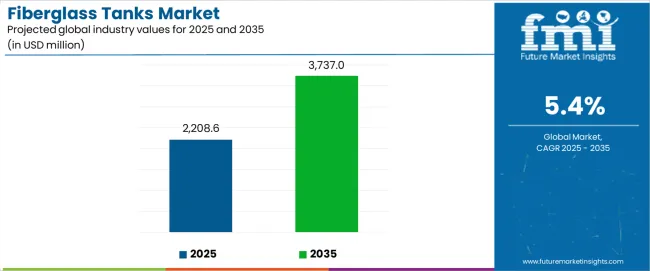
The fiberglass tanks market demonstrates distinct growth phases with varying market characteristics and competitive dynamics. Between 2025 and 2030, the fiberglass tanks market progresses through its advanced composite adoption phase, expanding from USD 2,208.6 million to USD 2,872.9 million with steady annual increments averaging 5.4% growth. This period showcases the transition from basic fiberglass constructions to advanced multi-layer systems with enhanced chemical resistance and integrated structural reinforcement becoming mainstream features.
The 2025-2030 phase adds USD 664.3 million to market value, representing 43% of total decade expansion. Market maturation factors include standardization of thickness specifications, declining material costs for high-performance resins, and increasing industrial awareness of composite tank benefits reaching 75-80% effectiveness in chemical storage applications. Competitive landscape evolution during this period features established manufacturers like KBK Industries and GSC Tank expanding their product portfolios while new entrants focus on specialized corrosion-resistant solutions and enhanced pressure-rated technology.
From 2030 to 2035, market dynamics shift toward advanced customization and multi-sector deployment, with growth accelerating from USD 2,872.9 million to USD 3,737 million, adding USD 864.1 million or 57% of total expansion. This phase transition logic centers on universal high-performance systems, integration with automated industrial equipment, and deployment across diverse application scenarios, becoming standard rather than specialized storage formats. The competitive environment matures with focus shifting from basic construction to comprehensive chemical compatibility and integration with modern industrial process operations.
| Metric | Value |
|---|---|
| Market Value (2025) | USD 2,208.6 million |
| Market Forecast (2035) | USD 3,737 million |
| Growth Rate | 5.40% CAGR |
| Leading Manufacturing Process | Hand Lay-up |
| Primary Application | Chemical Industry |
The fiberglass tanks market demonstrates strong fundamentals with hand lay-up manufacturing capturing a dominant share through superior design flexibility and cost-effective production capabilities. Chemical industry applications drive primary demand, supported by increasing industrial chemical storage requirements and enhanced corrosion resistance management solutions. Geographic expansion remains concentrated in developed markets with established chemical processing infrastructure, while emerging economies show accelerating adoption rates driven by industrialization projects and rising industrial facility development activity.
Market expansion rests on three fundamental shifts driving adoption across industrial and commercial sectors. Industrial modernization creates compelling advantages through fiberglass tank systems that provide comprehensive chemical resistance with superior corrosion protection, enabling facilities to manage aggressive chemicals and maintain process integrity while ensuring long-term reliability and justifying investment over traditional steel or concrete storage methods. Chemical processing facility expansion accelerates as industries worldwide seek reliable storage systems that deliver operational efficiency directly to production operations, enabling cost reduction that aligns with facility management expectations and maximizes chemical handling productivity. Environmental compliance increases drive adoption from industrial consumers requiring durable storage solutions that maximize containment reliability while maintaining leak-proof performance during extended service operations.
However, growth faces headwinds from raw material price variations that differ across resin suppliers regarding cost stability and supply chain reliability, potentially limiting margin consistency in price-sensitive industrial categories. Manufacturing complexity also persists regarding specialized fabrication requirements and skilled labor availability that may increase production costs in markets with demanding technical specifications.
The fiberglass tanks market represents a compelling intersection of industrial storage innovation, composite material advancement, and chemical containment optimization management. With robust growth projected from USD 2,208.6 million in 2025 to USD 3,737 million by 2035 at a 5.40% CAGR, this market is driven by increasing industrial expansion trends, chemical processing requirements, and municipal demand for reliable storage formats.
The fiberglass tanks market's expansion reflects a fundamental shift in how chemical facilities and industrial operations approach storage infrastructure. Strong growth opportunities exist across diverse applications, from chemical processing operations requiring corrosion-resistant containment to power generation facilities demanding high-pressure solutions. Geographic expansion is particularly pronounced in Asia-Pacific markets, led by China (7.3% CAGR) and India (6.8% CAGR), while established markets in North America and Europe drive innovation and specialized segment development.
The dominance of hand lay-up manufacturing and chemical industry applications underscores the importance of proven composite technology and structural reliability in driving adoption. Material compatibility and manufacturing complexity remain key challenges, creating opportunities for companies that can deliver consistent performance while maintaining cost efficiency.
Primary Classification: The fiberglass tanks market segments by manufacturing process into Hand Lay-up, Mechanical Wrapping, Filament Winding, and Pultrusion categories, representing the evolution from basic hand construction to advanced automated fabrication for comprehensive industrial storage operations.
Secondary Breakdown: Application segmentation divides the fiberglass tanks market into Chemical Industry, Electric Power, Metallurgy, Food & Medicine, Water Treatment, Oil & Gas, and others, reflecting distinct requirements for chemical compatibility, pressure ratings, and temperature specifications.
Regional Classification: Geographic distribution covers North America, Europe, Asia Pacific, Latin America, and the Middle East & Africa, with developed markets leading innovation while emerging economies show accelerating growth patterns driven by industrial development programs.
The segmentation structure reveals technology progression from standard hand lay-up construction toward integrated automated fabrication platforms with enhanced structural and chemical resistance capabilities, while application diversity spans from chemical processing operations to power generation facilities requiring comprehensive storage management and leak-proof containment solutions.
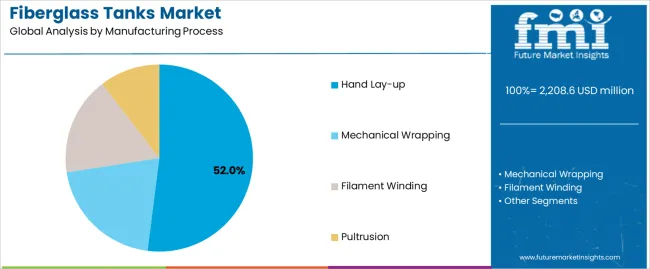
Hand lay-up segment is estimated to account for 52% of the fiberglass tanks market share in 2025. The segment's leading position stems from its fundamental role as a critical component in custom tank fabrication and its extensive use across multiple industrial and commercial sectors. Hand lay-up's dominance is attributed to its superior design flexibility, excellent customization capabilities, and balanced cost-effectiveness that make it indispensable for specialized storage applications.
Market Position: Hand lay-up systems command the leading position in the fiberglass tanks market through advanced composite technologies, including comprehensive thickness control, uniform resin distribution, and reliable construction performance that enable producers to deploy storage solutions across diverse industrial environments.
Value Drivers: The segment benefits from industrial preference for proven fabrication profiles that provide exceptional customization without requiring automated equipment costs. Efficient construction processes enable deployment in chemical tanks, power generation vessels, and processing applications where design flexibility and cost efficiency represent critical selection requirements.
Competitive Advantages: Hand lay-up systems differentiate through excellent structural integrity, proven chemical resistance, and compatibility with specialized design requirements that enhance storage capabilities while maintaining economical fabrication profiles suitable for diverse industrial applications.
Key market characteristics:
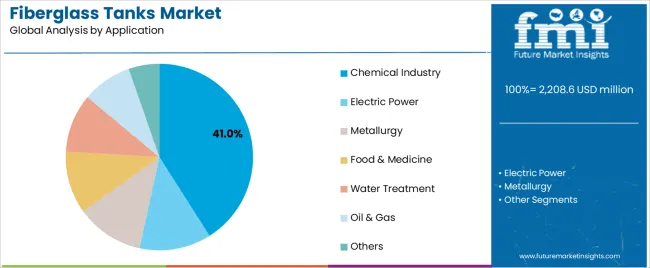
Chemical Industry segment is projected to hold 41% of the fiberglass tanks market share in 2025. The segment's market leadership is driven by the extensive use of fiberglass tanks in chemical processing, acid storage, solvent containment, and process chemical applications, where composite materials serve as both a corrosion barrier and structural solution. The chemical industry sector's consistent demand for corrosion-resistant storage supports the segment's dominant position.
Market Context: Chemical industry applications dominate the fiberglass tanks market due to widespread adoption of corrosion-resistant storage solutions and increasing focus on chemical compatibility, leak prevention, and process integrity that enhance manufacturing operations while maintaining safety standards.
Appeal Factors: Chemical processors prioritize corrosion resistance, structural reliability, and integration with processing equipment that enable coordinated deployment across multiple storage needs. The segment benefits from substantial industrial growth and facility modernization that emphasize reliable containment systems for chemical processing applications.
Growth Drivers: Industrial chemical programs incorporate fiberglass tanks as standard components for acid storage and processing operations. At the same time, safety initiatives are increasing demand for premium features that comply with environmental standards and enhance operational reliability.
Market Challenges: Raw material cost fluctuations and specialized fabrication requirements may limit deployment flexibility in ultra-price-sensitive markets or regions with varying industrial requirements.
Application dynamics include:
Growth Accelerators: Industrial expansion drives primary adoption as fiberglass tank systems provide exceptional corrosion resistance that enables chemical storage without material degradation, supporting process improvement and facility efficiency that require reliable composite formats. Chemical processing growth accelerates market expansion as facilities seek corrosion-resistant storage solutions that maintain integrity during extended service while enhancing operational convenience through standardized designs and equipment compatibility. Environmental compliance increases worldwide, creating sustained demand for leak-proof containment systems that complement industrial operations and provide operational advantages in chemical handling efficiency.
Growth Inhibitors: Raw material volatility challenges differ across resin markets regarding price stability and supply chain consistency, which may limit margin predictability and cost planning in price-sensitive industrial categories with demanding affordability requirements. Manufacturing complexity persists regarding specialized fabrication techniques and skilled labor availability that may increase production costs in jurisdictions with strict quality control protocols. Market fragmentation across multiple design specifications and capacity standards creates compatibility concerns between different industrial systems and existing storage infrastructure.
Market Evolution Patterns: Adoption accelerates in chemical and industrial sectors where corrosion resistance benefits justify material investments, with geographic concentration in developed markets transitioning toward mainstream adoption in emerging economies driven by industrialization and chemical processing development. Technology advancement focuses on enhanced composite properties, improved manufacturing efficiency, and integration with automated fabrication systems that optimize storage performance and production consistency. The fiberglass tanks market could face disruption if alternative storage materials or manufacturing technologies significantly challenge traditional fiberglass tank advantages in industrial applications.
The fiberglass tanks market demonstrates varied regional dynamics with growth leaders including China (7.3% CAGR) and India (6.8% CAGR) driving expansion through industrial growth and chemical processing modernization. Steady Performers encompass Germany (6.2% CAGR), Brazil (5.7% CAGR), the USA (5.1% CAGR), the UK (4.6% CAGR), and Japan (4.1% CAGR), benefiting from established industrial infrastructure and advanced application adoption.
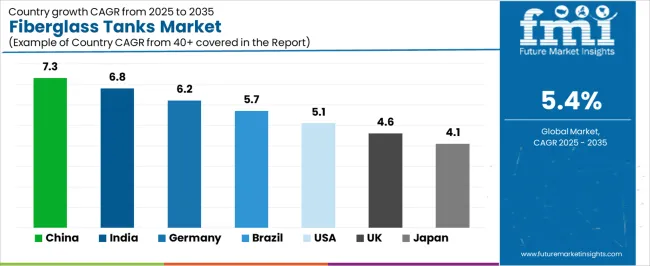
| Country | CAGR (2025-2035) |
|---|---|
| China | 7.3% |
| India | 6.8% |
| Germany | 6.2% |
| Brazil | 5.7% |
| USA | 5.1% |
| UUK | 4.6% |
| Japan | 4.1% |
Regional synthesis reveals Asia-Pacific markets leading growth through industrial expansion and chemical processing development, while European countries maintain steady expansion supported by specialized applications and environmental compliance requirements. North American markets show strong growth driven by chemical industry demand and industrial facility upgrades.
China establishes regional leadership through rapid industrial development and comprehensive chemical processing modernization, integrating advanced fiberglass tank systems as standard components in petrochemical facilities and industrial storage operations. The country's 7.3% CAGR through 2035 reflects manufacturing growth promoting industrial density and chemical infrastructure development that mandate the use of reliable corrosion-resistant systems in processing operations. Growth concentrates in major industrial regions, including Jiangsu, Shandong, and Guangdong, where chemical complexes showcase integrated fiberglass tank systems that appeal to facility managers seeking enhanced storage reliability and international processing standards.
Chinese manufacturers are developing innovative tank solutions that combine local production advantages with international quality specifications, including multi-layer constructions and advanced chemical-resistant capabilities.
Strategic Market Indicators:
The Indian market emphasizes chemical processing applications, including rapid industrial development and comprehensive manufacturing expansion that increasingly incorporates fiberglass tanks for chemical storage and processing applications. The country is projected to show a 6.8% CAGR through 2035, driven by massive industrialization activity under manufacturing initiatives and chemical demand for standardized, high-performance storage systems. Indian chemical facilities prioritize cost-effectiveness with fiberglass tanks delivering operational efficiency through economical material usage and reliable corrosion performance capabilities.
Technology deployment channels include major chemical complexes, processing companies, and industrial developers that support high-volume usage for domestic and export applications.
Performance Metrics:
The German market emphasizes advanced tank features, including innovative composite technologies and integration with comprehensive industrial platforms that manage chemical storage, power generation, and processing applications through unified containment systems. The country is projected to show a 6.2% CAGR through 2035, driven by industrial modernization under environmental compliance trends and facility demand for premium, reliable storage systems. German industrial facilities prioritize precision with fiberglass tanks delivering comprehensive storage management through enhanced corrosion protection and operational innovation.
Technology deployment channels include major chemical companies, power generators, and industrial developers that support custom development for premium operations.
Performance Metrics:
In São Paulo, Rio de Janeiro, and Bahia, Brazilian industrial facilities and chemical operators are implementing advanced fiberglass tank systems to enhance storage capabilities and support operational efficiency that aligns with industrial protocols and processing standards. The Brazilian market demonstrates sustained growth with a 5.7% CAGR through 2035, driven by industrial development programs and facility investments that emphasize reliable containment systems for chemical and processing applications. Brazilian industrial facilities are prioritizing tank systems that provide exceptional corrosion resistance while maintaining compliance with environmental standards and minimizing maintenance complexity, particularly important in chemical processing and power generation operations.
Market expansion benefits from industrial programs that mandate enhanced storage in facility specifications, creating sustained demand across Brazil's chemical and industrial sectors, where leak prevention and material consistency represent critical requirements.
Strategic Market Indicators:
The USA market emphasizes advanced tank features, including innovative composite technologies and integration with comprehensive industrial platforms that manage chemical processing, power generation, and specialty applications through unified storage systems. The country is projected to show a 5.1% CAGR through 2035, driven by industrial expansion under facility modernization trends and chemical demand for premium, reliable containment systems. American industrial facilities prioritize innovation with fiberglass tanks delivering comprehensive storage management through enhanced chemical compatibility and operational efficiency.
Technology deployment channels include major chemical companies, utility operators, and industrial developers that support custom development for specialized operations.
Performance Metrics:
The UK market emphasizes specialized tank applications, including innovative composite systems and integration with industrial processing platforms that manage chemical storage, power generation, and pharmaceutical applications through unified containment systems. The country is projected to show a 4.6% CAGR through 2035, driven by industrial modernization under environmental compliance trends and facility demand for premium, reliable storage systems. British industrial facilities prioritize quality with fiberglass tanks delivering comprehensive storage management through enhanced corrosion protection and regulatory compliance.
Technology deployment channels include major chemical companies, pharmaceutical manufacturers, and industrial developers that support specialized development for regulated operations.
Performance Metrics:
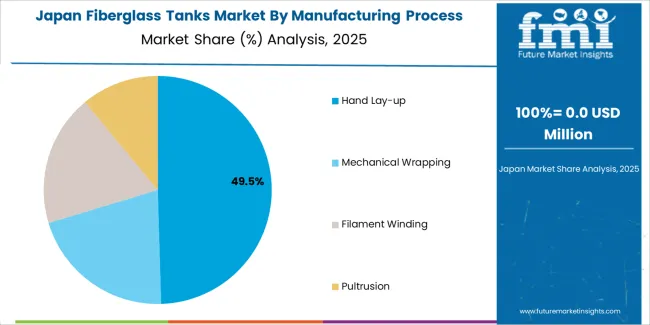
Japan's sophisticated industrial market demonstrates meticulous fiberglass tank deployment, growing at 4.1% CAGR, with documented operational excellence in chemical processing and industrial applications through integration with existing manufacturing systems and quality assurance infrastructure. The country leverages engineering expertise in composite manufacturing and tank fabrication to maintain market leadership. Industrial centers, including Tokyo, Osaka, and Nagoya, showcase advanced installations where tank systems integrate with comprehensive processing platforms and storage systems to optimize industrial operations and operational efficiency.
Japanese industrial facilities prioritize containment precision and material consistency in product selection, creating demand for premium tank systems with advanced features, including specialized resins and integration with automated processing protocols. The fiberglass tanks market benefits from established industrial infrastructure and willingness to invest in specialized composite technologies that provide superior chemical resistance and regulatory compliance.
Market Intelligence Brief:
The fiberglass tanks market in Europe is projected to grow from USD 487.2 million in 2025 to USD 742.8 million by 2035, registering a CAGR of 4.3% over the forecast period. Germany is expected to maintain its leadership position with a 38.2% market share in 2025, declining slightly to 37.8% by 2035, supported by its industrial excellence and major chemical processing centers, including North Rhine-Westphalia and Bavaria.
France follows with a 22.4% share in 2025, projected to reach 23.1% by 2035, driven by comprehensive chemical industry programs and industrial facility initiatives. The United Kingdom holds a 19.7% share in 2025, expected to maintain 20.2% by 2035 through established chemical sectors and industrial adoption. Italy commands a 11.8% share, while Spain accounts for 6.9% in 2025. The Rest of Europe region is anticipated to gain momentum, expanding its collective share from 1% to 1.6% by 2035, attributed to increasing industrial development in Eastern European countries and emerging chemical processing programs implementing standardized storage systems.
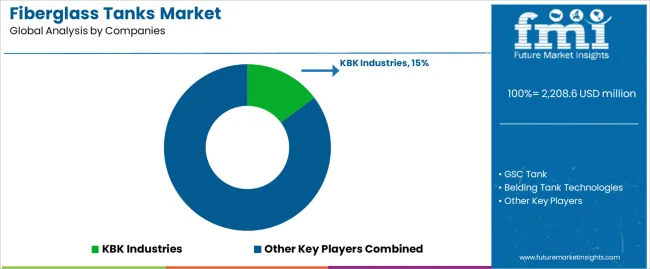
The fiberglass tanks market operates with moderate concentration, featuring approximately 15-22 participants, where leading companies control roughly 38-45% of the global market share through established distribution networks and comprehensive fabrication capabilities. Competition emphasizes structural performance, chemical compatibility, and manufacturing consistency rather than premium feature rivalry.
Market leaders encompass KBK Industries, GSC Tank, and Belding Tank Technologies, which maintain competitive advantages through extensive composite manufacturing expertise, global distribution networks, and comprehensive technical support capabilities that create industrial loyalty and support facility requirements. These companies leverage decades of fabrication experience and ongoing technology investments to develop advanced tank systems with exceptional corrosion resistance and structural features.
Specialty challengers include Belco Manufacturing Company, Augusta Fiberglass, and Marjan Factory Company, which compete through specialized application innovation focus and efficient manufacturing solutions that appeal to industrial buyers seeking reliable performance formats and custom design flexibility. These companies differentiate through operational efficiency emphasis and specialized market focus.
Market dynamics favor participants that combine consistent structural performance with advanced manufacturing support, including custom fabrication and installation capabilities. Competitive pressure intensifies as traditional steel tank manufacturers expand into fiberglass systems. At the same time, specialized composite converters challenge established players through innovative resin formulations and cost-effective production targeting emerging industrial segments.
| Item | Value |
|---|---|
| Quantitative Units | USD 2,208.6 million |
| Manufacturing Process | Hand Lay-up, Mechanical Wrapping, Filament Winding, Pultrusion |
| Application | Chemical Industry, Electric Power, Metallurgy, Food & Medicine, Water Treatment, Oil & Gas, Others |
| Regions Covered | North America, Europe, Asia Pacific, Latin America, Middle East & Africa |
| Countries Covered | China, India, Germany, Brazil, USA, UK, Japan, and 25+ additional countries |
| Key Companies Profiled | KBK Industries, GSC Tank, Belding Tank Technologies, Belco Manufacturing Company, Augusta Fiberglass |
| Additional Attributes | Dollar sales by manufacturing process and application categories, regional adoption trends across Asia Pacific, North America, and Europe, competitive landscape with composite manufacturers and tank fabricators, industrial preferences for corrosion resistance and structural integrity, integration with chemical processing equipment and storage systems, innovations in composite technology and multi-layer systems, and development of specialized containment solutions with enhanced chemical compatibility and pressure-rated features |
The global fiberglass tanks market is estimated to be valued at USD 2,208.6 million in 2025.
The market size for the fiberglass tanks market is projected to reach USD 3,737.0 million by 2035.
The fiberglass tanks market is expected to grow at a 5.4% CAGR between 2025 and 2035.
The key product types in fiberglass tanks market are hand lay-up, mechanical wrapping, filament winding and pultrusion.
In terms of application, chemical industry segment to command 41.0% share in the fiberglass tanks market in 2025.






Full Research Suite comprises of:
Market outlook & trends analysis
Interviews & case studies
Strategic recommendations
Vendor profiles & capabilities analysis
5-year forecasts
8 regions and 60+ country-level data splits
Market segment data splits
12 months of continuous data updates
DELIVERED AS:
PDF EXCEL ONLINE
Fiberglass Market Size and Share Forecast Outlook 2025 to 2035
Fiberglass Fabric Market Size and Share Forecast Outlook 2025 to 2035
Fiberglass Duct Wrap Insulation Market Size and Share Forecast Outlook 2025 to 2035
Fiberglass Filters Market Size and Share Forecast Outlook 2025 to 2035
Fiberglass Light Poles Market Size and Share Forecast Outlook 2025 to 2035
Fiberglass Electrical Enclosure Market Analysis - Size, Share & Forecast 2025 to 2035
Fiberglass Cloth Market
CNG Tanks Cylinders Market Growth - Trends & Forecast 2025 to 2035
Surge Tanks Market Growth - Trends & Forecast 2025 to 2035
Shrink Tanks Market
Cryogenic Tanks Market Size and Share Forecast Outlook 2025 to 2035
Global Wine Tanks Market
Flexible Water Tanks Market
Hydrogen Storage Tanks and Transportation Market Size and Share Forecast Outlook 2025 to 2035
Hydrogen Storage Tanks Market Size and Share Forecast Outlook 2025 to 2035
Aboveground Storage Tanks Market Size and Share Forecast Outlook 2025 to 2035
Underground Storage Tanks Market

Thank you!
You will receive an email from our Business Development Manager. Please be sure to check your SPAM/JUNK folder too.
Chat With
MaRIA